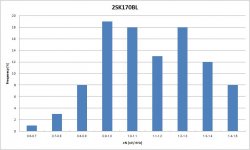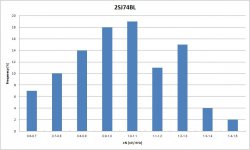Originally posted by kamis
Joshua G should have seen A Real Vendetta thread of this forum with complete schematics ,including first stage regulator he eventually has got after too many versions.
I've read this thread from post #1 and seen lot of schematics, including Vendetta.
However, should you follow how the regulator I came up with evolved, you'll see I didn't copy anything.
Should I wish to copy anything, I'd do so to begin with – but may be not publish the fact that I'm copying.
Anyhow, the regulator I came up with, with the blessed assistance of John Curl, is similar to the Vendetta's Phono Amplifier – but not identical.
Originally posted by kamis
Voltage reference with constant current and resistors is described in many older electronic books.
So?
Originally posted by kamis
2SK170 is not best solution for CCS, since it is a high gm device. I select J-fets with 5ma idss and combinaton of resistor and preset pot. for R2. It is much easier to adjust voltage value in this way. Low noise BJT could be used instead of J-fets for pass transistors.
Do you know of any BJT with noise figure similar to 2SK170?
john curl said:Stay with what you have Joshua_G.
Thank you, John.
I'm not well educated, not by credentials, however, life taught me few lessons.
One of those lessons is to select who's advise to follow.
syn08 said:
And, of course, that's all you care about. Real performance (line and load regulation, output impedance, etc...) is for real engineers only, isn't it?
Fellow human being,
I'm not ashamed to learn from anyone.
I'm definitely not ashamed to learn from the person who designed some of the finest audio gear, ever.
I'm not ashamed to give credit the people I learned from and was inspired by.
Please show me your design with REAL outstanding performance (by listening tests, not on paper) – and I'd be proud to learn from you and credit you.
John Curl: Courage's emulation will not work in the real world.
I trust your comment, but it wasn't my idea nor schematic. I just presented the DC values generated at several points in the schematic with a 200 Ohm load. Nothing less, nothing more.
Perhaps you may point out why it will not work in the real world, so we all can learn something.
Thanks
syn08 said:
Real performance (line and load regulation, output impedance, etc.
Decisions have to be made according to the circuit which the regulator feeds.
When lowest noise is desired for a constant current client – JFETs are best.
When lowest output Z is desired – MOSFETs are best.
Life needs compromises.
Audio circuit designs need compromises.
To each its' own.
Each specific circuit will dictate its' compromises.
Joshua_G said:
Audio circuit designs need compromises.
Joshua, so you think of yourself as an audio circuit designer inspired by JC now?
Holy ****
Stinius
Joshua_G said:
Decisions have to be made according to the circuit which the regulator feeds.
When lowest noise is desired for a constant current client – JFETs are best.
When lowest output Z is desired – MOSFETs are best.
Life needs compromises.
Audio circuit designs need compromises. To each its' own.
Each specific circuit will dictate its' compromises.
I'm now starting to collect these gems

Now, if John would understand (or care) what kind of damage you bring to his own reputation... Really, and now I'm dead serious, to me it's a very sad picture. John deserves much more than this...
stinius said:
Joshua, so you think of yourself as an audio circuit designer inspired by JC now?
Holy ****
No, I'm not a designer.
I didn't say I'm a designer.
This is a circuit I came up with – with the blessed help of John Curl.
However, I'm aware of some design considerations – which assist me to come up with some circuits.
And yes – the circuits I come up with, since I started reading this thread, are inspired by John Curl.
Anyhow, I wonder if your concern is an engineering one, or a personal one.
So – what is your concern?
syn08 said:
I'm now starting to collect these gemsI haven't had so much fun in ages

Now, if John would understand (or care) what kind of damage you bring to his own reputation... Really, and now I'm dead serious, to me it's a very sad picture. John deserves much more than this...
Do you care about John's reputation?
If you do – what is your input towards this end?
If you don't – what are you blubbering about?
Do you care about John's reputation?
I do, yes. He's a good friend. Which is why, even though I learn stuff from him and am delighted to use ideas of his and bounce mine off of him, I don't use his name to try to enhance the credibility (such as it is!) of my work.
Sigurd Ruschkow said:If you have the noise data on paper, I can do the transfer from paper to Excel. Just email me the raw data.
Thank you, I just did it myself.
2SK170 @ Id=5mA (to keep all the population under or at Idss), Vds=10V, f=1KHz, common source.
Edit: 5mA
Attachments
Joshua_G said:Do you care about John's reputation?
Well, surprise surprise, I do. But respect and truth do not necessary overlap.
JoshuaJoshua_G said:
No, I'm not a designer.
I didn't say I'm a designer.
This is a circuit I came up with – with the blessed help of John Curl.
However, I'm aware of some design considerations – which assist me to come up with some circuits.
And yes – the circuits I come up with, since I started reading this thread, are inspired by John Curl.
Anyhow, I wonder if your concern is an engineering one, or a personal one.
So – what is your concern?
First:
Why don’t you just use your first circuit?
Second:
I’m concerned about the reputation of JC, and that you are taking him with you in to the mud.
Like this thread has become he must answer for himself and also try to support you.
If you had any respect to JC you wouldn’t post whatever you came up with and expect John to support you.
It seems like you don’t have any respect at all to the people you are posting with, I don’t like that kind of behaviour. I respect JC, and if I didn’t respect him and his work I wouldn’t argue with him and I think that is the same with everybody else in this thread.
Stinius
syn08 said:
Thank you, I just did it myself.
2SK170 @ Id=5mA (to keep all the population under or at Idss), Vds=10V, f=1KHz, common source.
Edit: 5mA
I once had to argue with a QC guy that there is no tail on noise distribution that goes down to 0.
Jakob2 said:OT
The reasoning is based on pure psychoacoustics.
So it would lead to a design of filters with a lot less pre-ringing and a lot more post-ringing instead.
And psychoacoustics are based on averaged assumptions, not trained audiophiles and designers who handle 'sonics (sonic results are changed by the single change) changing' components in bit-by-bit incremental 'single cause analysis' experiments.
This then cascades into arguments like '640k ought to be enough for anybody', and similar type thinking.
I'm not arguing with you, just saying that when it comes to the human condition, averaging and 'black and white' measurements and statements bear little-to-zero resemblance to the scientific ideals. This is similar to any science that has not been around long or involves the human condition. This can make the nuts and bolts scientific crowd very itchy.
I usually carry out at least one single cause analysis experiment, in audio, every day. In the end, about 250-200... per year. Minimum. I get upset and restless when I'm not doing something every day of that nature.
SY said:
I do note that the top subjective reviewer at that time, J. Gordon Holt, went ape-$#@! with both the first CD player and the F1 recorder, declaring them as close to perfection as anything he'd ever heard. Hmmmm.
After a while, he began to hear the flaws among the components that where improved.
It did not take long for him to change his mind.
john curl said:I could be wrong about the terminology. I am not a digital engineer, BUT if any part of the signal precedes the main signal in an impulse, then I think that the ear can be effected by that artifact.
it definitely does. the ear/brain combination is a fantastic editorialization and constructional device when it comes to pulling intelligence out of a difficult signal. However, we should not need to train the ear to dig through disgusting artifacts, we should leave it alone to relax into hearing (not 'fight to decode'- a very critical and important point!!!) a realistic portrayal of the original event. Doing so, at this time...requires a decent analog rig.
Listening to something that is a fabricated bit-by-bit 'simile' of an analog original is a fools game of the highest order, UNLESS the micro information is also included which in essence can be inter-channel 'timing cues' for spacial locational information.. This requires a high sampling rate. Once again, one that is capable of just over a clean sinusoidal signal of 100khz.
I proposed that exact point back in the early 90's on the alt.rec.high-end group..and explained exactly why. Funny how it took this long to make it true.
Tube amps rolled off at 15kz can do this better than any digital system - either in existence, proposed, or imagined.
Joshua_G I have used this design of yours as an example of good audio design.
For the record, I tried for months to come up with a better design than this for the new Vendetta phono input stage power supply regulator. I was unhappy with every other configuration, however, maybe someone, somewhere will show me an approach that I will ultimately find better. Please, those who know better, put up your circuit. I must warn you that I might not be too polite, if you really go off the rails with an inappropriate approach, after all the criticism of the existing circuit presented here.
For the record, I tried for months to come up with a better design than this for the new Vendetta phono input stage power supply regulator. I was unhappy with every other configuration, however, maybe someone, somewhere will show me an approach that I will ultimately find better. Please, those who know better, put up your circuit. I must warn you that I might not be too polite, if you really go off the rails with an inappropriate approach, after all the criticism of the existing circuit presented here.
syn08 said:
Mr. Jung and yourself could use some lessons about high performance/low noise regulators, isn't it? Joshua, with John's friendly support, beat you hands down with his outstanding design. You'd better burn your credentials and hide in the woods after this!
And FWIW what is the load regulation?
Music signals are all complex ever changing transient draw situations that require perfection across the board under any and all complex transient loads.
Beyond basic stability and noise issues, the results of any possible linear or constant draw measurement is entirely irrelevant.
- Status
- Not open for further replies.
- Home
- Amplifiers
- Solid State
- John Curl's Blowtorch preamplifier

